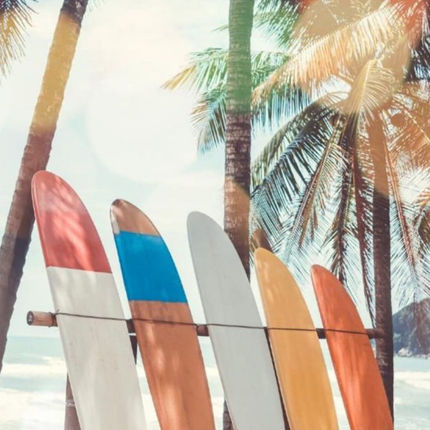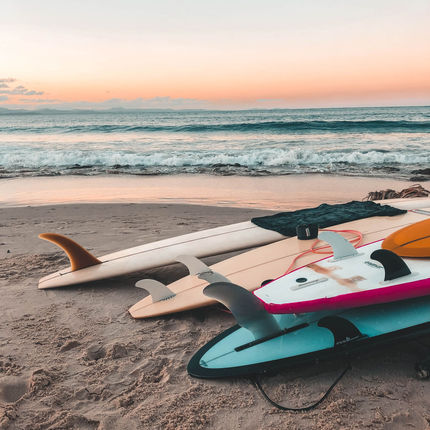top of page

Best Surf Spots Puerto Vallarta

SAN PANCHO
It’s slowly becoming one of the mainstays of the Riviera Nayarit, mainly for its pristine golden-sand beach and Pacific-front villas. The break here is pretty consistent, although it’s not the nicest wave in the area. You’re looking at a beach-reef mix underfoot with a steep take off and lots of potential close outs on bigger days. The best spot is probably the mix of point breaks that come of the headland to the south end of the bay.
• Left-hand river mouth break, sand bottom
• Works on south swells, wind sensitive, only works after the river mouth has opened due to rain. Not for beginners.
• Get to San Francisco town (San Pancho) (10 min. north of Sayulita) then go all the way down the main street until you get to the beach.
• Left-hand river mouth break, sand bottom
• Works on south swells, wind sensitive, only works after the river mouth has opened due to rain. Not for beginners.
• Get to San Francisco town (San Pancho) (10 min. north of Sayulita) then go all the way down the main street until you get to the beach.

SAYULITA
Sayulita surfing is some of the most famous surfing in all of Mexico. A happening town of bars and surf shops, it’s got loads in the way of tuition and surf camps for those putting together their first ever Puerto Vallarta surfing trip. The waves are good for novices, too. There are three in the town itself. One’s a super-chilled beach break over sand (pop up practice perfect). The other two are left- and right-hand reef breaks with rocks below, offering somewhere to progress to.
• Right and left point break and a beginner sand bar.
• Rock bottom on a point break.
• Best on low and mid tides.
• Generally crowded.
• Right in front of the town of Sayulita.
• Right and left point break and a beginner sand bar.
• Rock bottom on a point break.
• Best on low and mid tides.
• Generally crowded.
• Right in front of the town of Sayulita.

LITIBU BEACH
A not-so-popular beach break that can get messy, Litibu is the main playa of Higuera Blanca. You can travel here in around 45 minutes if you come direct from the airport in Puerto Vallarta. Just be warned there isn’t much in the way of bars and eateries. Only a couple of villas string along the shore, facing waves that are largely closeouts when above chest high. It’s got potentia on smaller days and when Sayulita is packed!
• Beachbreak.
• Beautiful empty beach with great car access.
• Mostly closeout waves, good for beginners to ride the foam.
• Best on small or no swell.
• Beachbreak.
• Beautiful empty beach with great car access.
• Mostly closeout waves, good for beginners to ride the foam.
• Best on small or no swell.

THE COVER OR LA BAHIA
The first break you come to as you enter the realm of Punta Mita surf. It’s an area that caps off the northernmost end of the Bahia de Banderas. It’s also got some of the best Puerto Vallarta surfing going! Look for a water taxi to take you straight to the break. It’s a little far out on the headland, where it forms a lovely right-hand point that can carry some pretty long rides on rippable waves. Take the shortie and try to time it for high tide – otherwise the rocks can be exposed.
• Reef break, mostly right-handers with some short lefts, good for shortboards.
• Works on all tides. Caution: reef very exposed on low tide.
• Reef break, mostly right-handers with some short lefts, good for shortboards.
• Works on all tides. Caution: reef very exposed on low tide.

THE LIGHTHOUSE OR EL FARO
When the stars align on a N swell during the winter and you catch good N-NE offshore winds, things can be gnarly. It’s a right-hander point break with pretty nice rides that can be both fast and slow, depending on the swell strength. We’d say it’s mainly an intermediate wave, but it also gets its fair share of improvers looking to pop up on a rocky bottom.
• Right-hand point break, long rides, great for longboards and shortboard
• Best at low and medium tides; breaks on shallow reefs.
• Works only with larger north swells (6 ft plus) and north wind.
• Right-hand point break, long rides, great for longboards and shortboard
• Best at low and medium tides; breaks on shallow reefs.
• Works only with larger north swells (6 ft plus) and north wind.

ANCLOTE
The Anclote relies on the heavy S-SW summer swells to get kicking. Even at its best, it’s just a mellow break that the longboarders love. However, the real draw is the long ride, which can even go for up to more than 0.5km. Ride it on mid tide and look for those northerly offshores for the best conditions.
• Right-hand reef break, long and mellow wave, perfect for longboarding or SUPing.
• Needs a pretty big and powerful south or north swell to break.
• Take care on low tide, reef bottom, no sand.
• Right in front of the town of Punta de Mita.
• Right-hand reef break, long and mellow wave, perfect for longboarding or SUPing.
• Needs a pretty big and powerful south or north swell to break.
• Take care on low tide, reef bottom, no sand.
• Right in front of the town of Punta de Mita.

STINKY´S
Stinky’s is right next door to El Anclote. It’s way more consistent, named for the salt-smelling fishing boats that meet in the nearby cove. The wave itself is a chilled, glassy break over sand and rocks that has both left and rights. It’s good for beginners and can even be quite quick. Works best at chest height.
• Works at low tide and on large north or south swells.
• Sand and rocky, easy access.
• Once in the town of Punta de Mita, follow the signs to La Quinta del Sol, this will lead you to the access path to Stinky's (parking alongside the road).
• Works at low tide and on large north or south swells.
• Sand and rocky, easy access.
• Once in the town of Punta de Mita, follow the signs to La Quinta del Sol, this will lead you to the access path to Stinky's (parking alongside the road).

PALMITAS
One of the best beach breaks on the whole Puerto Vallarta surfing line up, Palmitas sits just to the west of Punta de Mita. It’s a heavy beach break that wedges up and can go both left and right. Can get quite strong in the summer S-SW swells but sits nicely at shoulder or overhead during the winter months. Rippable peaks that are a nice challenge for more experienced riders.
• Punchy beach break that works on short period north swells with north winds.
• Mid to high tide.
• Shortboard only.
• 5-minute hike from La Lancha, 20-minute hike from Stinky’s.
• Punchy beach break that works on short period north swells with north winds.
• Mid to high tide.
• Shortboard only.
• 5-minute hike from La Lancha, 20-minute hike from Stinky’s.

LA LANCHA BEACH
It’s got two separate breaks that are located on the same beach – and it’s a seriously gorgeous beach: White sand, stooping palms, pure blue water. It’s just a little less than an hour’s drive north out of Puerto Vallarta. Most people come as part of a surf school, but you can also find parking for your own car in the nearby petrol station. The first break is a chilled right hander close to the shore. The more challenging left-hand wedge breaks a hefty paddle out, but it’s quick and offers good drop ins.
• Mellow reef break. Mostly a right good for longboarding sometimes has a good left that’s good for shortboards.
• Works at all tides but at the lowest tide, there are exposed rocks.
• Located in Punta Mita, WildMex school location.
• Mellow reef break. Mostly a right good for longboarding sometimes has a good left that’s good for shortboards.
• Works at all tides but at the lowest tide, there are exposed rocks.
• Located in Punta Mita, WildMex school location.

BURROS
Takes us further east along the Punta Mita surf shoreline, closer to the airport of Puerto Vallarta itself. The wave is a glassy right-hander that breaks over reef-rock underfoot. It can hold up well – around 10ft on heavy summer days. However, it usually works with much less than that, although chest- or shoulder-high conditions are better for the beginners and improvers. You’re looking at a five-minute walk to the wave from the main road out of Puerto Vallarta, and then a 100m paddle to the break itself.
• Reef break, mostly rights, occasional left.
• Best at low tide and south swells.
• Gets easily crowded.
• Access next to Palladium Hotel, turn off the main road toward Palladium.
• Reef break, mostly rights, occasional left.
• Best at low tide and south swells.
• Gets easily crowded.
• Access next to Palladium Hotel, turn off the main road toward Palladium.

PAREDON
• Right-hand reef-point break.
• Long rides with lots of sections.
• Best on higher tides.
• Needs a big south swell to work.
• Next to Veneros.
• Long rides with lots of sections.
• Best on higher tides.
• Needs a big south swell to work.
• Next to Veneros.

VENEROS
Veneros is considered one of the shortboard meccas of the Puerto Vallarta surfing scene. It’s got quick take offs and rippable right- and left-handers that come off lovely wedges. It works best on strong southerly swells, which are far more common in the summer months. Offshores are from the north-east. Head in for the morning session to catch the glassy part of the day.
• Right-hand reef-point break.
• Long rides with lots of sections.
• Best on higher tides.
• Needs a big south swell to work.
• Next to Veneros.
• Right-hand reef-point break.
• Long rides with lots of sections.
• Best on higher tides.
• Needs a big south swell to work.
• Next to Veneros.

QUIMIXTO
Quimixto is one of the few well-known breaks that sit to the south of Puerto Vallarta itself. You can find it tucked between gorgeous jungles and white-sand beaches amid some of the most beutiaful coves on the Bahia de Banderas. As far as the wave goes, this one’s more of a classic beach break compared to its compadres to the north. Because it draws in good power from the N-NW winter swells, it’s a prime option for the popular months of December and January. Bigger days are best left to the experienced surfers because Quimixto can get hollow and barrel. We’d recommend asking at a local surf school if the swell is right for a beginner lesson if that’s what you’re after.
bottom of page